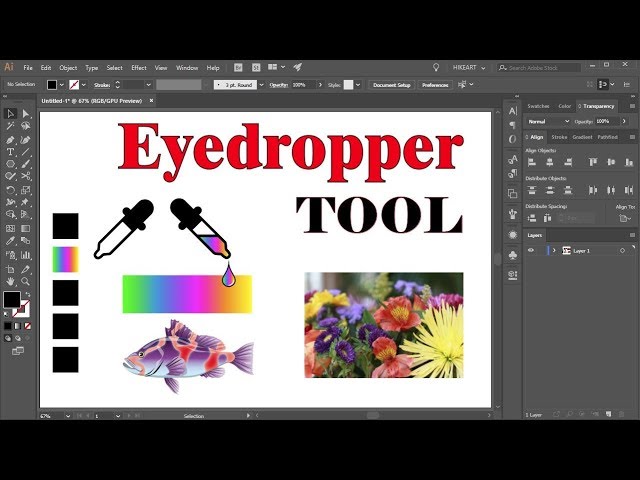Unveiling the Magic: A Comprehensive Guide to Mastering the Eyedropper Tool in Adobe Illustrator

Introduction: In the world of digital design, colors play a vital role in conveying mood, emotion, and meaning. Adobe Illustrator, a leading vector graphics editor, offers a plethora of tools to manipulate colors effortlessly. Among these, the Eyedropper Tool stands out as a versatile instrument that allows designers to sample, select, and apply colors with precision and efficiency. In this extensive guide, we’ll delve into the depths of the Eyedropper Tool in Adobe Illustrator, exploring its functionalities, techniques, and creative applications.
Part 1: Understanding the Eyedropper Tool
- Introduction to the Eyedropper Tool: The Eyedropper Tool in Adobe Illustrator is a simple yet powerful tool that enables users to sample colors from existing artwork and apply them to other objects or elements within the document.
- Functionality and Applications: The primary function of the Eyedropper Tool is to pick up color attributes, including fill, stroke, and gradient properties, from one object and apply them to another. It is particularly useful for maintaining color consistency and harmony across a design project.
- Location and Shortcut: You can access the Eyedropper Tool by selecting it from the Tools panel or by pressing the “I” key on your keyboard. Once activated, the cursor changes to an eyedropper icon, indicating that you’re ready to sample colors.
Part 2: Basic Techniques for Using the Eyedropper Tool
- Sampling Colors: To sample a color, simply click on any object within your Illustrator document while the Eyedropper Tool is active. Illustrator will pick up the color attributes of the selected object and apply them to the current fill or stroke color.
- Applying Colors: After sampling a color, you can apply it to other objects by clicking on them with the Eyedropper Tool active. This allows you to quickly replicate colors across multiple elements within your design.
- Modifying Properties: The Eyedropper Tool not only samples colors but also captures other attributes such as stroke weight, opacity, and effects. You can use it to replicate complex styles and effects from one object to another seamlessly.
Part 3: Advanced Techniques and Tips
- Sampling from Images: The Eyedropper Tool can sample colors not only from vector objects but also from raster images embedded within your Illustrator document. This feature is particularly handy for matching colors to reference images or photographs.
- Sampling Across Documents: You can use the Eyedropper Tool to sample colors from one Illustrator document and apply them to another. Simply open both documents simultaneously and switch between them while the Eyedropper Tool is active.
- Customizing Eyedropper Options: Adobe Illustrator offers several options to customize the behavior of the Eyedropper Tool. You can choose whether to sample all attributes or only specific ones, such as fill or stroke color, in the Eyedropper Options panel.
- Using the Option/Alt Key: Holding down the Option (Alt) key while clicking with the Eyedropper Tool allows you to sample colors without changing the active tool temporarily. This is useful for quickly sampling colors while working with other tools or functions.
Part 4: Creative Applications of the Eyedropper Tool
- Color Matching and Harmonization: The Eyedropper Tool is invaluable for matching colors across different elements within a design, ensuring consistency and harmony. Use it to harmonize colors between text, shapes, and illustrations effortlessly.
- Color Exploration and Inspiration: Experiment with the Eyedropper Tool to explore color combinations and find inspiration for your designs. Sample colors from photographs, artwork, or nature to discover new palettes and creative possibilities.
- Replicating Brand Colors: When working on branding projects, use the Eyedropper Tool to match colors to brand guidelines or existing assets accurately. This ensures that your designs align with the brand’s identity and maintain brand consistency.
- Creating Gradient Transitions: The Eyedropper Tool can be used to create smooth gradient transitions between objects or elements. Sample colors from one object and apply them to another with gradient fills, allowing you to achieve seamless blending effects.
Conclusion:
In conclusion, the Eyedropper Tool in Adobe Illustrator is a versatile and indispensable tool for color sampling, matching, and application. By mastering the techniques and tips outlined in this guide, you’ll be able to wield the Eyedropper Tool with confidence and efficiency, unlocking a world of creative possibilities in your designs. Whether you’re matching colors, exploring palettes, or replicating styles, the Eyedropper Tool is your trusted companion for achieving color perfection in Adobe Illustrator. So, dive in, experiment fearlessly, and let the Eyedropper Tool be your guide to vibrant and harmonious designs!




